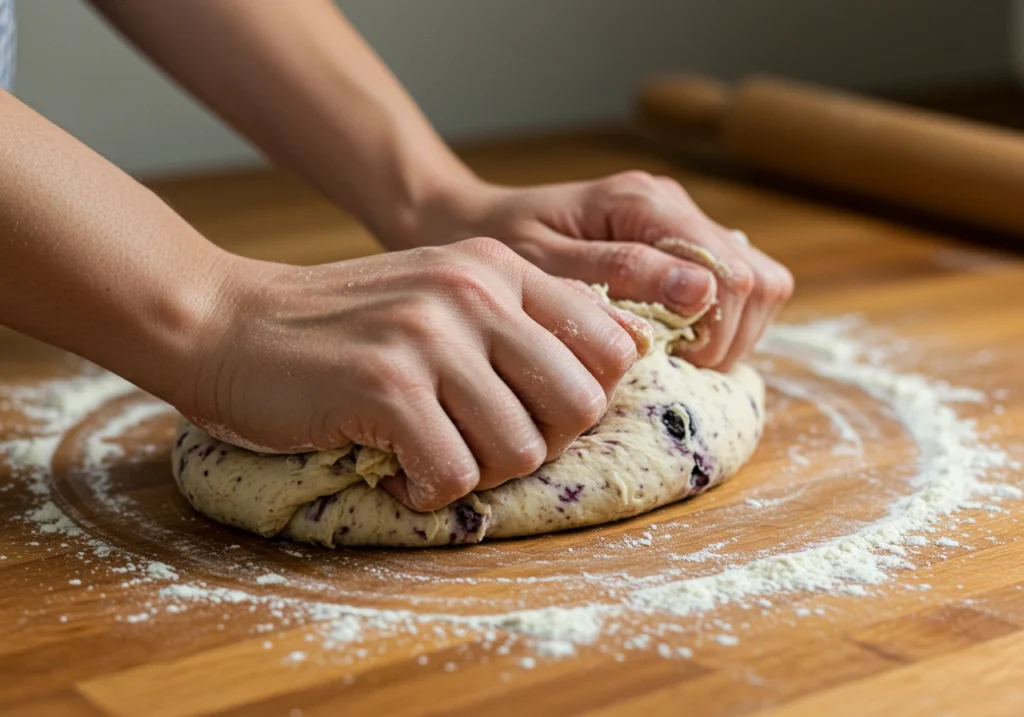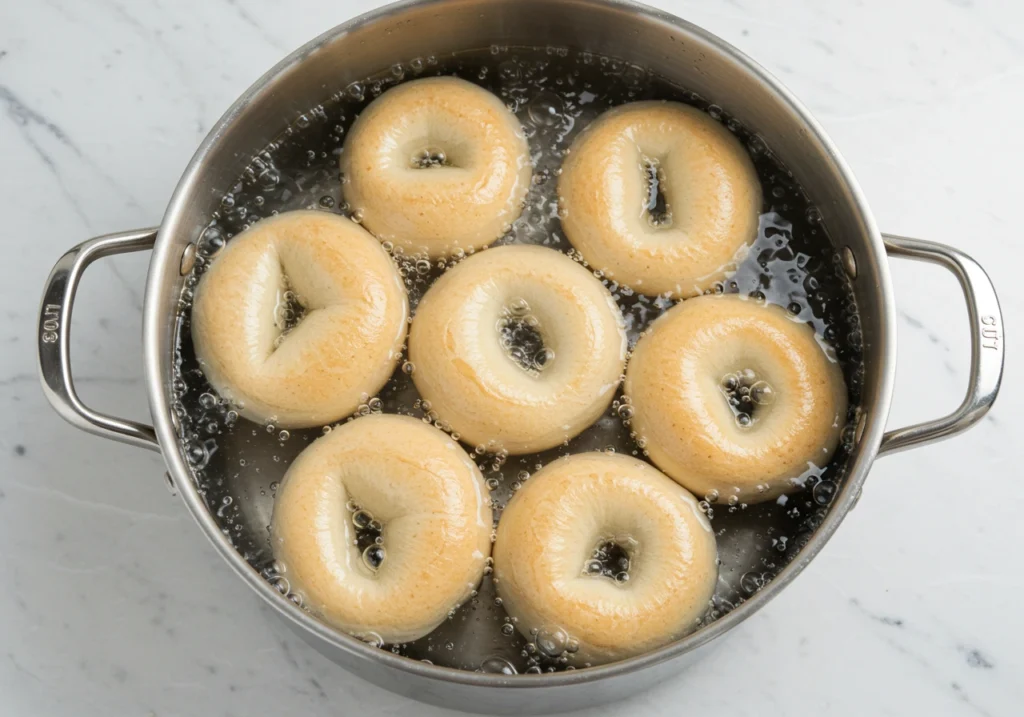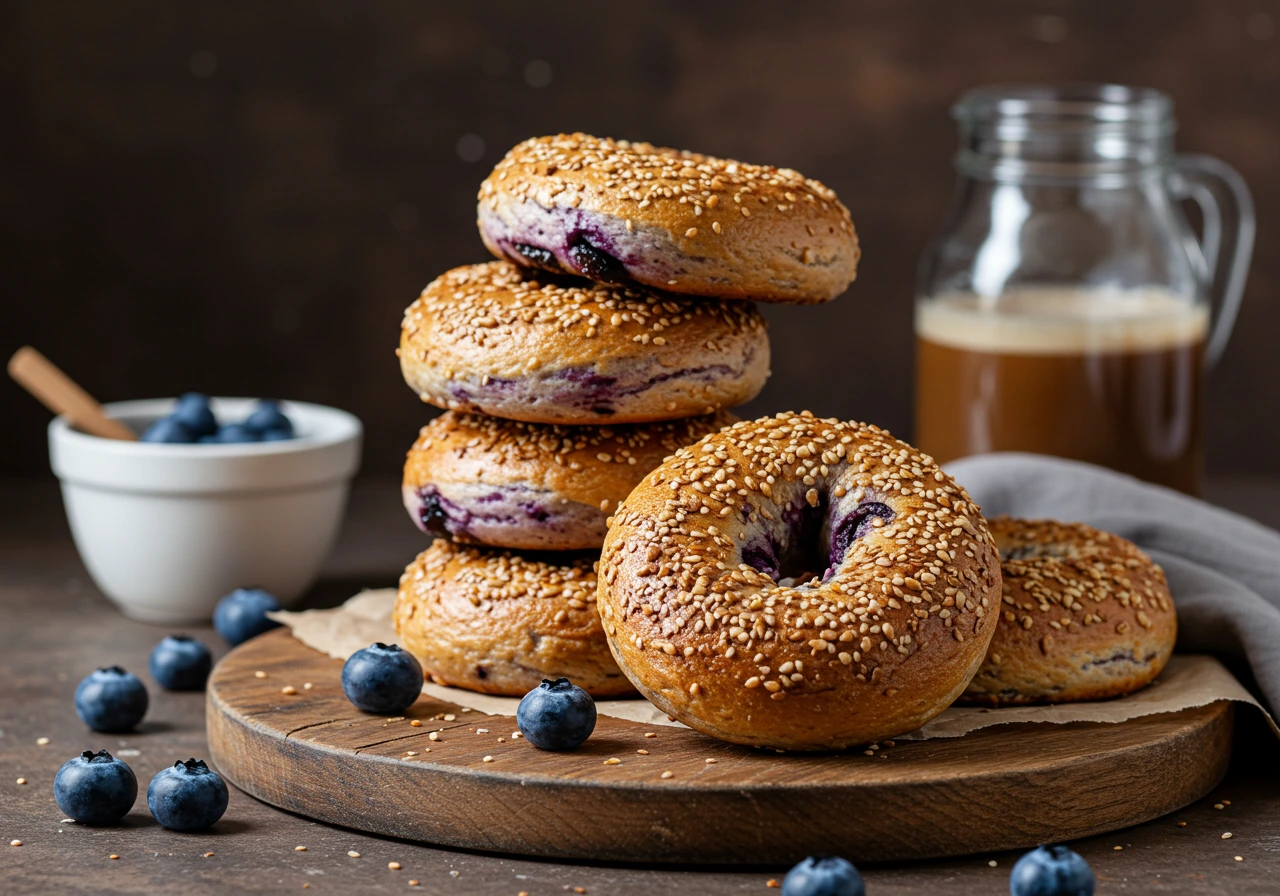Introduction
Imagine biting into a warm, chewy blueberry bagel recipe straight from your oven, the burst of sweet blueberries balancing the soft yet slightly crispy crust. Sounds heavenly, right? Whether you’re a seasoned baker or just getting started, making homemade blueberry bagels is easier than you think.
This article will take you through everything—ingredients, techniques, troubleshooting tips, and storage hacks. By the end, you’ll know how to create bakery-style bagels in your kitchen. Plus, we’ll dive into delicious serving ideas and answer the most common questions about making the best blueberry bagels. So, let’s get started with Part 1!
Part 1: Introduction to blueberry bagel recipe
The Popularity of Bagels in Breakfast Culture
Bagels have long been a breakfast staple. Originally brought to America by Jewish immigrants in the early 1900s, bagels quickly became a beloved morning treat, especially in cities like New York and Montreal. Their chewy texture and slight crunch make them the perfect base for cream cheese, butter, or more elaborate toppings.
What makes bagels so appealing? It’s the boiling process. Unlike traditional bread, bagels are boiled before baking, giving them a dense and chewy bite that sets them apart. And when blueberries are added to the mix, they introduce a subtle sweetness that complements the savory nature of traditional bagels.
The Unique Appeal of Blueberry Bagels
There’s something about blueberries that makes them an irresistible addition to bagels. These tiny berries bring:
- A natural sweetness without being overwhelming.
- A burst of juicy flavor in every bite.
- A subtle tartness that balances the dough’s richness.
- A visually stunning purple-blue swirl in the baked bagel.
Additionally, blueberry bagels provide health benefits! Blueberries are packed with antioxidants, vitamins, and fiber, making your morning carb indulgence a little more nutritious. For a deeper dive into blueberry health benefits, check out this resource.
What Makes a Perfect blueberry bagel recipe?
A good blueberry bagel isn’t just about throwing some berries into the dough. The best ones have:
- A golden-brown, slightly crispy crust.
- A soft but dense, chewy interior.
- A well-distributed blueberry flavor, with blueberries incorporated without making the dough too wet.
- A hint of sweetness balanced by the natural tang of yeast fermentation.
But here’s the thing: not all blueberry bagels are created equal! Some store-bought versions taste artificial, have an overly sweet flavor, or lack the satisfying chewiness of a properly boiled bagel. That’s why making them at home is a game-changer.
Part 2: Understanding the Ingredients
Key Ingredients in blueberry bagel recipe
When it comes to baking homemade blueberry bagels, the right ingredients make all the difference. Bagels require a delicate balance of structure, chewiness, and flavor, and every ingredient plays a crucial role. Unlike other breads, bagels have a denser texture, which means that everything—from the flour to the blueberries—affects the final result.
A classic blueberry bagel contains:
- Flour for structure
- Yeast for fermentation and rise
- Sweetener to enhance flavor
- Salt to balance sweetness and control yeast activity
- Blueberries for the signature fruity taste
- Water to hydrate the dough and help gluten formation
Now, let’s break down these key components so you can make the best blueberry bagels possible.
Flour Selection: Bread Flour vs. All-Purpose Flour
One of the biggest decisions when making bagels is choosing the right flour. Since bagels are known for their chewy texture, the type of flour you use will impact the final product.
Bread Flour (Recommended)
Bread flour is the gold standard for bagels. Why? It has a higher protein content (typically 12–14%), which leads to: A stronger gluten network
A chewier and more elastic texture
Bagels that hold their shape well
Bagel dough needs strong gluten development, which is why most professional bakeries use high-gluten flour (a step above bread flour). If you want an authentic, New York-style chew, bread flour is your best bet.
All-Purpose Flour (Acceptable Alternative)
If you don’t have bread flour on hand, all-purpose flour can still work. However, it has less protein (around 10–12%), which means: A softer, less chewy texture
A slightly looser crumb
A weaker dough that may spread more during boiling
While all-purpose flour can make decent bagels, they won’t have the iconic dense chewiness that bagel lovers crave. If using it, try adding 1–2 teaspoons of vital wheat gluten per cup to improve elasticity.
Yeast Types: Active Dry Yeast vs. Instant Yeast
Yeast is essential for fermentation, helping bagels develop their structure and complex flavor. But which yeast should you use?
Active Dry Yeast
- Needs to be proofed in warm water before using
- Slower fermentation but results in deeper flavor
- Requires about 15 minutes to activate
- Ideal for bakers who prefer overnight fermentation
Instant Yeast (Recommended)
- Can be mixed directly into flour (no proofing required)
- Rises faster than active dry yeast
- Produces a light, airy texture
- Great for beginners or those who want a quicker process
👉 If using active dry yeast instead of instant yeast, increase the quantity by 25% to achieve the same rise.
Sweeteners: Sugar, Honey, or Maple Syrup?
Bagels aren’t overly sweet, but a touch of sweetener helps balance flavors and feeds the yeast. Here’s how different sweeteners affect your dough:
Granulated Sugar
Most common and neutral in flavor
Helps yeast activate
Creates a slightly firmer texture
Honey (Recommended)
Adds a subtle floral sweetness
Helps bagels retain moisture
Results in a slightly softer texture
Maple Syrup
Brings a deep, caramel-like sweetness
Works well with whole wheat bagels
Can slightly loosen dough
👉 If substituting honey or maple syrup for sugar, reduce the total liquid content slightly to maintain dough consistency.
Blueberries: Fresh, Frozen, or Dried?
Ah, the star ingredient! But which type of blueberry works best?
Fresh Blueberries (Best Option)
Deliver juicy bursts of flavor
Create beautiful swirls in the dough
Can be tricky—excess moisture can make dough too wet
Pro Tip: Toss fresh blueberries in a little flour before mixing them into the dough to prevent bleeding.
Frozen Blueberries
Work well when fresh ones aren’t available
Must be used directly from frozen (thawed ones will leak juice)
Dried Blueberries
Provide a chewier texture
Won’t make dough too wet
More concentrated sweetness
For the best balance, try a mix of fresh and dried blueberries to get both juicy bursts and chewy bites.
Part 3: Step-by-Step Recipe Guide
How to Make blueberry bagel recipe at Home
Now that you know the best ingredients for making chewy, flavorful blueberry bagel recipe, it’s time to bring them to life. While bagel-making requires a few steps, don’t worry—each stage contributes to that signature texture and taste.
Homemade bagels are totally worth the effort, and once you taste the perfect combination of golden crust, chewy bite, and sweet blueberry bursts, you’ll never want store-bought again!
Let’s jump into the process. Follow these step-by-step instructions, and in just a few hours, you’ll be enjoying warm, fresh blueberry bagels straight from your oven.
Preparing the Blueberries
Blueberries are the star of this recipe, but how you prepare them can make or break your dough. The wrong approach can leave you with soggy, unevenly flavored bagels. Here’s how to get it right.
Fresh Blueberries
- Best for bursts of juiciness.
- To prevent them from bleeding into the dough, rinse and pat dry with a paper towel.
- Toss them lightly in flour before mixing them in—this helps absorb extra moisture.
Frozen Blueberries
- Great when fresh ones aren’t available.
- Use them directly from the freezer to prevent excess juice from seeping into the dough.
- Do not thaw before adding them.
Dried Blueberries
- Ideal for a more even texture and chewy sweetness.
- If they seem too hard, soak them in warm water for 5–10 minutes, then pat dry before use.
Pro Tip: Mixing blueberries too early in the dough process can cause excessive bleeding, leading to purple-tinted bagels. For best results, fold them in after the first rise.

Mixing and Kneading the Dough
Bagel dough is denser and firmer than most bread doughs—it’s not as soft as sandwich bread, but that’s what gives bagels their chewy bite.
Ingredients
- 4 cups bread flour (or high-gluten flour)
- 1 packet (2 ¼ tsp) instant yeast
- 1 ½ tsp salt
- 2 tbsp granulated sugar or honey
- 1 ¼ cups warm water (around 110°F)
- 1 cup prepared blueberries (see previous section)
Step-by-Step Instructions
- Activate the yeast (if using active dry yeast) – Mix yeast, warm water, and 1 tsp sugar. Let it sit for 5–10 minutes until foamy.
- Mix the dry ingredients – In a large bowl, whisk together the flour, salt, and remaining sugar.
- Add the liquid – Pour in the yeast mixture (or just warm water if using instant yeast). Mix with a wooden spoon or dough hook until a shaggy dough forms.
- Knead the dough – Transfer to a floured surface and knead for 10–12 minutes until smooth and elastic. If using a stand mixer, knead on medium speed for 8 minutes.
- Fold in the blueberries – Gently knead in half of the blueberries, being careful not to crush them. Reserve the rest to add before shaping.
💡 The dough should be slightly stiff but not dry. If it feels too sticky, add 1 tbsp of flour at a time until manageable.

First Rise: Allowing the Dough to Rest
At this stage, we need to let the yeast work its magic! This first rise allows the gluten to develop and gives the bagels their structure.
How to Let the Dough Rise
- Place the dough in a lightly greased bowl.
- Cover with plastic wrap or a damp towel.
- Let it rise at room temperature for 60–90 minutes or until doubled in size.
⏳ Overnight Option: For extra flavor, let the dough rise slowly in the fridge for 12–18 hours.
Shaping the Bagels
Now for the fun part—giving your bagels that classic round shape with a hole in the center!
Steps for Shaping Perfect Bagels
- Divide the dough – Punch down the risen dough and divide it into 8 equal portions.
- Form dough balls – Roll each piece into a smooth ball.
- Add remaining blueberries – Press a few blueberries into each ball as you shape them.
- Make the hole – Use your finger to poke a hole in the center, then gently stretch the hole to about 1.5 inches wide.
💡 Pro Tip: The hole will shrink as the bagels rise and bake, so make it larger than you think!
- Second rise – Place shaped bagels on a parchment-lined baking sheet. Cover and let them rest for 20–30 minutes.
Boiling the Bagels: Purpose and Technique
Bagels have one unique step that sets them apart from regular bread—boiling! This is crucial for achieving the chewy, glossy crust.
Why Boil Bagels?
- Locks in shape – Stops bagels from expanding too much in the oven.
- Creates a chewy crust – The quick burst of heat gelatinizes the surface.
- Enhances flavor – Some bagel shops even add honey or malt syrup to the water for extra taste.
Boiling Instructions
- Bring a large pot of water to a gentle boil.
- Add 1 tbsp of honey or sugar to enhance browning.
- Drop 2–3 bagels at a time into the water.
- Boil for 45–60 seconds per side.
- Remove with a slotted spoon and place back on the baking sheet.
💡 For extra chewiness: Boil for 90 seconds per side.

Baking to Perfection
Now it’s time to bake your bagels to golden-brown perfection! This step transforms them from doughy rounds into crisp, chewy masterpieces.
Baking Instructions
- Preheat the oven to 425°F (218°C).
- Optional: Add toppings – Brush bagels with egg wash for shine and sprinkle with coarse sugar, oats, or seeds if desired.
- Bake for 18–22 minutes, rotating halfway for even browning.
- Cool completely – Transfer to a wire rack and let sit for at least 15 minutes before slicing.

🥯 Pro Tip: If you like extra-crispy bagels, bake for an additional 2–3 minutes.
Part 4: Enhancing Your blueberry bagel recipe
So, you’ve mastered the classic blueberry bagel recipe, but why stop there? There are plenty of ways to elevate the flavor and texture of your homemade bagels! Whether you prefer a hint of citrus, a warm cinnamon swirl, or a crunchy topping, these easy customizations will take your bagels to the next level.
Here’s how you can add a unique twist to your homemade blueberry bagel recipe.
Incorporating Lemon Zest or Vanilla Extract
Want to give your bagels a subtle, aromatic boost? Lemon zest and vanilla extract work beautifully with blueberries, enhancing their natural sweetness while adding depth to the flavor profile.
✔️ Lemon Zest: Adds a fresh, slightly tart contrast to the blueberries. Simply grate the zest of one lemon into the dough while mixing.
✔️ Vanilla Extract: Gives the bagels a warm, sweet aroma that makes them taste like blueberry muffins in bagel form. Add 1 teaspoon of pure vanilla extract to the dough for a light, comforting sweetness.
💡 Pro Tip: Pairing both lemon zest and vanilla creates a bakery-style flavor that’s irresistible!
Adding a Cinnamon Swirl
Cinnamon and blueberries? Absolutely! Adding a cinnamon swirl to your bagels creates a warm, slightly spiced flavor that makes them perfect for breakfast or an afternoon snack.
How to Add a Cinnamon Swirl
- Mix: Combine 2 tbsp brown sugar, 1 tbsp cinnamon, and 1 tbsp melted butter in a small bowl.
- Layer: Before shaping the bagels, roll out each dough ball slightly, spread a thin layer of the cinnamon mixture, then fold and shape as usual.
- Bake as usual – The cinnamon will create swirls inside the dough, offering pockets of sweet, spicy goodness in every bite!
💡 Bonus: A sprinkle of cinnamon sugar on top before baking enhances both flavor and texture!
Topping Ideas: Seeds, Oats, or Sugar Crystals
Bagel toppings add extra texture and crunch while making your bagels look bakery-fresh. Whether you prefer something sweet, nutty, or hearty, there’s a topping for you.
Coarse Sugar or Turbinado Sugar – Adds a slight crunch and an extra hint of sweetness.
Rolled Oats – Creates a hearty, wholesome texture with a rustic feel.
Chia, Sesame, or Sunflower Seeds – Offers a light crunch while boosting nutrition!
Cinnamon Sugar Dusting – If you love a little extra sweetness, a mix of cinnamon and sugar gives a caramelized crust when baked.
To apply toppings, simply brush bagels with egg wash before baking and sprinkle your choice of topping generously.
Part 5: Serving Suggestions
You’ve baked the perfect blueberry bagel recipe, but what’s next? A great bagel is only as good as what you put on it! Whether you prefer a classic cream cheese spread, nutty richness, or a creative sandwich, there are endless ways to enjoy your homemade blueberry bagels.
From sweet to savory, here are delicious pairing ideas to take your bagels to the next level!
Cream Cheese Spreads: Plain, Honey, or Flavored
Nothing beats the creaminess of a good spread on a fresh bagel. While classic plain cream cheese is always a winner, why not get creative?
Plain Cream Cheese: The classic choice that lets the blueberries shine.
Honey Cream Cheese: Mix 1 tbsp honey into softened cream cheese for a natural sweetness that enhances the blueberry flavor.
Berry Cream Cheese: Blend cream cheese with fresh blueberries (or a spoonful of jam) for a fruity twist.
Cinnamon or Vanilla Cream Cheese: Add ½ tsp cinnamon or vanilla extract to your spread for an aromatic boost.
💡 Pro Tip: Use whipped cream cheese for an extra-light and airy texture!
Nut Butters and Fruit Preserves
If you’re looking for a more natural and protein-packed option, nut butters and fruit preserves are fantastic choices.
Almond Butter & Honey: A protein-rich, slightly sweet combo that pairs beautifully with blueberry bagels.
Peanut Butter & Banana Slices: The classic PB & banana combo gets even better on a blueberry bagel!
Cashew Butter & Maple Syrup: A smooth, creamy spread with a touch of maple is heavenly on warm bagels.
Strawberry or Raspberry Jam: The tartness of berry jam complements the sweet bursts of blueberry.
Lemon Curd: If you love a citrusy zing, a swipe of lemon curd adds a bright and fresh contrast to the bagel’s sweetness.
Creating Bagel Sandwiches: Sweet and Savory Options
Why stop at just spreads? Turn your blueberry bagel recipe into a full meal with these delicious sandwich ideas:
Sweet Bagel Sandwiches
Blueberry & Ricotta Delight: Spread ricotta cheese on a bagel, drizzle with honey, and top with fresh blueberries.
Nutella & Strawberries: A chocolatey twist with Nutella and sliced strawberries for a decadent treat.
Greek Yogurt & Granola: A layer of Greek yogurt with a sprinkle of granola adds crunch and protein.
Savory Bagel Sandwiches
Cream Cheese & Smoked Salmon: The salty, smoky taste of salmon pairs beautifully with the sweet blueberries. Add some red onion and capers for a gourmet touch!
Goat Cheese & Arugula: A tangy, peppery combo that balances the sweetness of the bagel.
Turkey & Brie: The creaminess of brie and the savoriness of turkey make for an elegant and satisfying sandwich.
Part 6: Storage and Freshness Tips
So, you’ve baked a fresh batch of homemade blueberry bagel recipe but what if you can’t eat them all at once? No worries! Proper storage ensures your bagels stay fresh, chewy, and delicious for days or even weeks.
Whether you’re keeping them at room temperature or storing them for long-term enjoyment, these simple techniques will help preserve their perfect texture and flavor.
Short-Term Storage: Keeping Bagels Fresh
For the best taste and texture, bagels are best enjoyed fresh within the first 24 hours after baking. But if you need to store them for a few days, here’s how:
Room Temperature (1–2 Days):
- Store bagels in a paper bag or loosely wrapped in a clean kitchen towel to maintain their crisp crust.
- Avoid airtight plastic bags, as they trap moisture, making bagels soggy.
For Extra Freshness (3–4 Days):
- Place bagels in a zip-top bag or airtight container with a paper towel inside to absorb excess moisture.
- Toast or warm them before serving to revive their crusty, chewy texture.
💡 Pro Tip: Avoid refrigerating bagels! The cold air stales bread faster, making bagels dry and tough.
Long-Term Storage: Freezing Techniques
Need to save bagels for later? Freezing is the best way to preserve their freshness without sacrificing flavor or texture.
How to Freeze Bagels:
- Let bagels cool completely to prevent ice crystals from forming.
- Slice them in half for easy toasting later.
- Wrap each bagel tightly in plastic wrap or aluminum foil.
- Place wrapped bagels in a freezer-safe zip-top bag, squeezing out excess air.
How to Reheat Frozen Bagels:
- No need to thaw! Simply toast straight from the freezer for the best texture.
- If using an oven, bake at 375°F (190°C) for 5–7 minutes until warm and crispy.
💡 Pro Tip: If you prefer softer bagels, microwave them for 20–30 seconds before toasting!
Part 7: Frequently Asked Questions
Even after following the perfect blueberry bagel recipe, you might have some lingering questions about technique, ingredients, and ways to enhance your bagels. Don’t worry—I’ve got you covered!
Here are answers to some of the most common questions about making homemade blueberry bagel recipe.
How to Get Blueberry Flavor in Bagels?
To achieve a strong blueberry flavor, use a combination of fresh or frozen blueberries and blueberry extract. Fresh blueberries provide juicy bursts, while blueberry extract or dried blueberries enhance the overall taste. Adding a tablespoon of blueberry jam or puree to the dough can also intensify the flavor without altering the texture.
Are Fresh or Frozen Blueberries Better for Bagels?
Both options work, but each has pros and cons:
Fresh blueberries are best for bursts of natural juiciness but can release excess moisture.
Frozen blueberries are great for convenience—just mix them in without thawing to avoid staining the dough.
Dried blueberries provide even distribution and won’t affect the dough’s moisture content.
For the best balance, try using a mix of fresh and dried blueberries!
What Is the Secret to Making Bagels?
The key to perfect bagels is in the boiling process and the right flour!
Boiling bagels before baking gives them their signature chewy crust. Adding honey or sugar to the boiling water enhances the golden color.
Using bread flour or high-gluten flour ensures a strong dough structure, preventing bagels from being too soft or flat.
💡 Bonus tip: Letting the dough rest overnight in the fridge enhances the flavor!
How Do You Add Flavor to Bagels?
Enhancing bagels is easy! You can add:
Lemon zest or vanilla extract for a bright, aromatic taste.
Cinnamon or nutmeg for warmth and spice.
Honey or maple syrup to subtly sweeten the dough.
Flavored cream cheeses, seeds, or sugar toppings to customize the final product.
💡 For an extra gourmet twist, try a blueberry-cinnamon swirl dough!
Final Thoughts
There you have it—answers to the most common bagel-making questions! Now you’re fully prepared to create the best homemade blueberry bagel recipe with the perfect chew, flavor, and freshness.
Want even more creative bagel ideas? Check out our flavor variations, serving suggestions, and expert storage tips above! Happy baking! 🥯💙

